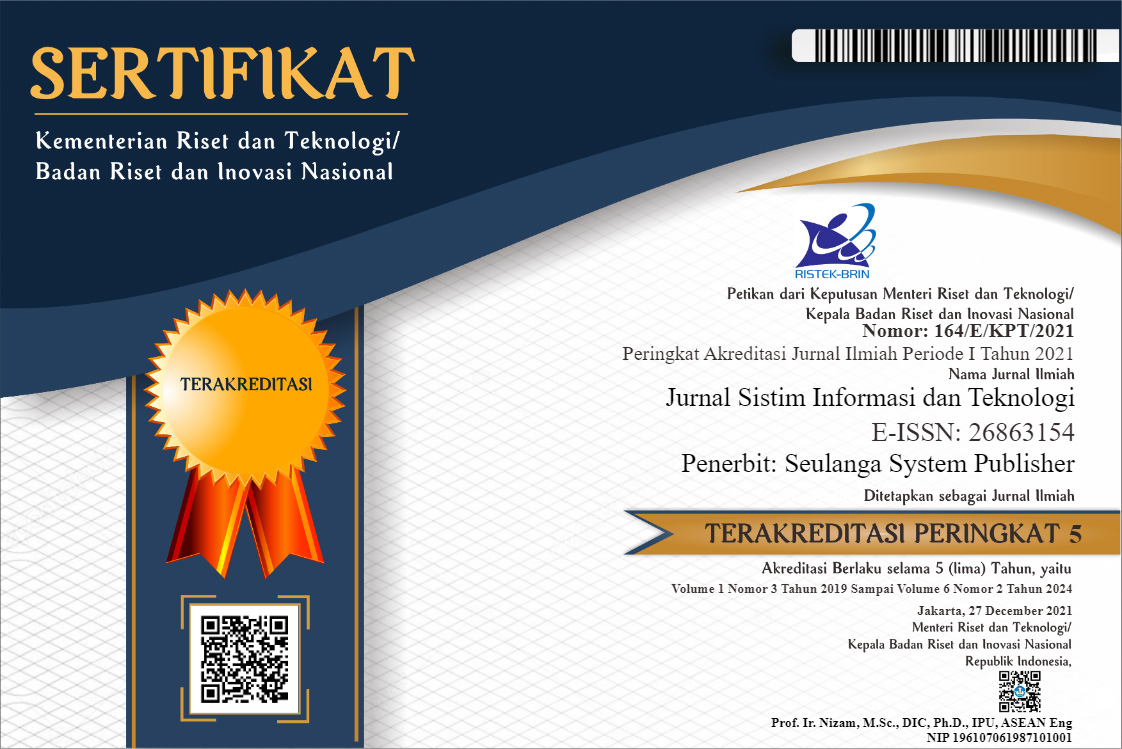Identifikasi Penderita COVID-19 Berdasarkan Chest X-Ray Menggunakan Algoritma Jaringan Syaraf Tiruan Backpropagation
DOI:
https://doi.org/10.37034/jsisfotek.v3i4.65Keywords:
VID-19, Chest X-Ray, Backpropagation, Pandemic, AlgorithmAbstract
Corona Virus Disease 2019 (COVID-19) is an infectious respiratory disease caused by the Severe Acute Respiratory Syndrome Coronavirus 2 (SARS-COV2). This disease first appeared in Wuhan, China and spread throughout the world. COVID-19 has had a major impact on public health around the world. On March 9, 2020, the World Health Organization (WHO) declared COVID-19 a pandemic. Early identification of people with COVID-19 can help limit the wider spread. One of the factors behind the rapid spread of the disease is the long clinical trial time. Rapid clinical testing is a challenge facing the spread of COVID-19. Most countries, including Indonesia, face the problem of lack of detection equipment and experts in diagnosing this disease. Chest X-Ray is one of the medical imaging techniques and also an alternative to identify the symptoms of pneumonia caused by COVID-19. This study aims to identify pneumonia caused by COVID-19 and other diseases based on Chest X-Ray. 107 Chest X-Ray images used as material for this study were obtained from the General Hospital of Ibnu Sina Padang Indonesia, which consisted of 27 images of pneumonia caused by COVID-19, 51 images with other diseases and 29 images of normal lungs. Then pre-processing is carried out as an initial stage and then feature extraction is carried out. Furthermore, the learning and identification process is carried out using the Backpropagation Artificial Neural Network (ANN) algorithm. In this study, 92 images were used as training data, and 15 images were used as test data. The results of calculations carried out using a network with a pattern of 16-100-100-100-2 obtained an accuracy value of 73%. The results of the identification prediction can be used as consideration in establishing a diagnosis of COVID-19 sufferers, but cannot be used as an absolute reference.
References
Sutikno, Waspada, I., Bahtiar, N., & Sasongko, P. S. (2016). Classification of motorcyclists not wear helmet on digital image with backpropagation neural network. Telkomnika (Telecommunication Computing Electronics and Control), 14(3), 1128–1133. https://doi.org/10.12928/TELKOMNIKA.v14i3.3486.
Sofiana, R., & Sutikno, S. (2018). Optimization of Backpropagation for Early Detection of Diabetes Mellitus. International Journal of Electrical and Computer Engineering (IJECE), 8(5), 3232. https://doi.org/10.11591/ijece.v8i5.pp3232-3237.
Tandrian, A. H., & Kusnadi, A. (2019). Pengenalan Pola Tulang Daun Dengan Jaringan Syaraf Tiruan Backpropagation. ULTIMA Computing, 10(2), 53–58. https://doi.org/10.31937/sk.v10i2.1063.
Syafria, F., Iqbal, B., Budianita, E., & Afrianty, I. (2018). Implementation of Backpropagation Neural Network to Detect Suspected Lung Disease. Indonesian Journal of Artificial Intelligence and Data Mining, 1(1), 32. https://doi.org/10.24014/ijaidm.v1i1.5023.
Juwita, A. R., & Solichin, A. (2018). Batik pattern identification using GLCM and artificial neural network backpropagation. Proceedings of the 3rd International Conference on Informatics and Computing, ICIC 2018, 1–6. https://doi.org/10.1109/IAC.2018.8780412.
Vasanthi, M., & Seetharaman, K. (2021). A hybrid method for biometric authentication-oriented face detection using autoregressive model with Bayes Backpropagation Neural Network. Soft Computing, 25(2), 1659–1680. https://doi.org/10.1007/s00500-020-05500-8.
Yuhandri, Madenda, S., Wibowo, E. P., & Karmilasari. (2017). Pattern Recognition and Classification Using Backpropagation Neural Network Algorithm for Songket Motifs Image Retrieval. International Journal on Advanced Science, Engineering and Information Technology, 7(6), 2343. https://doi:10.18517/ijaseit.7.6.2200.
Adi, K., Widodo, C. E., Widodo, A. P., Gernowo, R., Pamungkas, A., & Syifa, R. A. (2018). Detection lung cancer using Gray Level Co-Occurrence Matrix (GLCM) and back propagation neural network classification. Journal of Engineering Science and Technology Review, 11(2), 8–12. https://doi.org/10.25103/jestr.112.02.
Anifah, L., Haryanto, Harimurti, R., Permatasari, Z., Rusimamto, P. W., & Muhamad, A. R. (2018). Cancer lungs detection on CT scan image using artificial neural network backpropagation based gray level coocurrence matrices feature. 2017 International Conference on Advanced Computer Science and Information Systems, ICACSIS 2017, 2018-Januari(2010), 327–331. https://doi.org/10.1109/ICACSIS.2017.8355054.
Depinta, L., & Abdullah, Z. (2017). Implementasi Jaringan Syaraf Tiruan Backpropagation untuk Deteksi Penyakit Tuberculosis (TB) Paru dari Citra Rontgen. Jurnal Fisika Unand, 6(1), 61–66. https://doi.org/10.25077/jfu.6.1.61-66.2017.
Arulmurugan, R., & Anandakumar, H. (2018). Early detection of lung cancer using wavelet feature descriptor and feed forward back propagation neural networks classifier. Lecture Notes in Computational Vision and Biomechanics, 28, 103–110. https://doi.org/10.1007/978-3-319-71767-89.
Geetha, V., Aprameya, K. S., & Hinduja, D. M. (2020). Dental caries diagnosis in digital radiographs using back-propagation neural network. Health Information Science and Systems, 8(1). https://doi.org/10.1007/s13755-019-0096-y.
Jin, A., Yan, B., Hua, W., Feng, D., Xu, B., Liang, L., & Guo, C. (2020). "Clinical characteristics of patients diagnosed with COVID-19 in Beijing". Biosafety and Health, 2(2), 104–111. https://doi.org/10.1016/j.bsheal.2020.05.003.
Lin, Q., Zhao, S., Gao, D., Lou, Y., Yang, S., Musa, S. S., Wang, M. H., Cai, Y., Wang, W., Yang, L., & He, D. (2020). A conceptual model for the coronavirus disease 2019 (COVID-19) outbreak in Wuhan, China with individual reaction and governmental action. International Journal of Infectious Diseases, 93, 211–216. https://doi.org/10.1016/j.ijid.2020.02.058.
World Health Organization (2021). Coronavirus disease (COVID-19) Pandemic. [Online] (Updated 16 Maret 2021) Available at: https://www.who.int/emergencies/diseases/novel-coronavirus-2019. [Accessed 17 Maret 2021].
Li, C., Zhao, C., Bao, J., Tang, B., Wang, Y., & Gu, B. (2020). Laboratory diagnosis of coronavirus disease-2019 (COVID-19). Clinica Chimica Acta, 510, 35–46. https://doi.org/10.1016/j.cca.2020.06.045.
Giri, A. K., & Rana, D. R. (2020). Charting the challenges behind the testing of COVID-19 in developing countries: Nepal as a case study. Biosafety and Health, 2(2), 53–56. https://doi.org/10.1016/j.bsheal.2020.05.002.
Li, J., Long, X., Wang, X., Fang, F., Lv, X., Zhang, D., Sun, Y., Hu, S., Lin, Z., & Xiong, N. (2021). Radiology indispensable for tracking COVID-19. Diagnostic and Interventional Imaging, 102(2), 69–75. https://doi.org/10.1016/j.diii.2020.11.008.









